Journal of Modern Physics
Vol.3 No.9(2012), Article ID:22617,4 pages DOI:10.4236/jmp.2012.39131
Optimization of Diffraction Efficiency and Polarization Dependence Loss in Photopolymer Grating for Use in Multichip Module
1Sanjaya Memorial Institute of Technology, Berhampur, Odisa, India
2Ganjam College, Berhampur, Odisa, India
3National Institute of Science and Technology, Berhampur, Odisa, India
Email: lsahu1@rediffmail.com
Received June 30, 2012; revised August 3, 2012; accepted August 11, 2012
Keywords: Multiplexing; Demultiplexing; Modulation Index
ABSTRACT
We in this paper propose a model to increase the diffraction efficiency of a holographic grating at 1550 nm for multiplexing application. To use such a grating, polarization dependence loss is introduced analytically and then optimized for its minimum value. A configuration of holographic grating is proposed based on both maximum diffraction efficiency and minimum polarization dependence loss. The proposed grating is expected to find importance in optoelectronic multichip module.
1. Introduction
Wavelength division multiplexing (WDM) technology plays an important role for the next generation telecommunication network [1-3]. Today the exponential increase in world wide data traffic highly demands for a communication network of large bandwidth. This demand is now fulfilled by fiber-optic communication system using wavelength division multiplexing. The wavelength division multiplexing (WDM) based networks are now very popular option to gradually upgrade network transport capacity without huge investment in lying new optical cables. Several technologies are used to carry out wavelength separation for demultiplexing a composite signal. Very common technologies are thin film filters, arrayed waveguide grating (AWG) [4], fiber Bragg grating (FBG), free space diffraction grating [5-7]. FBGs based on diffraction have been used to constitute multichannel Mux/DeMux devices, in which all discrete filters must be cascaded in a serial manner. The insertion loss is increased with the channel number, and the channel uniformity becomes poor. Apart from the high cost of individual filters, the combination with other technologies, optical circulators for FBGs, will further increase system costs. It is proven that these types of DWDM Mux & DeMux devices are not suitable for high channel count use in view of the cost and performance. Furthermore, these types of devices have higher chromatic dispersion (±50 ps/nm - ±200 ps/nm), making these technologies unsuitable for high data transmission rate applications, such as 40 Gbit/s. AWG and Free space diffraction grating are widely used because AWG demultiplexers are having compactness in size and their potential to offer very high channel count and free space diffraction grating show many advantages including simplicity, the low crosstalk and low cost.
We in this paper presented a model to increase the diffraction efficiency of a holographic grating that can be used in AWG. To use such a grating for multiplexing application, polarization dependence loss is introduced analytically and then optimized for its minimum value. Then a configuration of holographic grating is proposed based on both maximum diffraction efficiency and minimum polarization dependence loss. The proposed grating is expected to find importance in opto-electronic multichip module.
2. Theory
We consider a volume transmission grating structure composed of N-index modulation grating recorded in a single-mode wave guiding layer such that the reconstructing angle “ ” satisfies the constructive interference Bragg’s condition given by the following equation
” satisfies the constructive interference Bragg’s condition given by the following equation
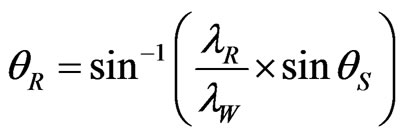 (1)
(1)
where  is the recording wavelength and
is the recording wavelength and  is the incident angle of signal beam,
is the incident angle of signal beam,  is incident wave length.
is incident wave length.
The angular separation  in terms of grating period
in terms of grating period  and reconstruction angle
and reconstruction angle  is given by [8]
is given by [8]
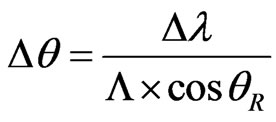 (2)
(2)
The diffraction grating has different efficiency according to incident polarization state and the index modulation amplitude. The diffraction efficiency relating to input polarization is expressed by the Kogelnik’s wave theory [9,10].
The diffraction efficiency for p-polarization and Spolarization [11] can be found to be
 (3)
(3)
and
 (4)
(4)
where  is the refractive index modulation amplitude
is the refractive index modulation amplitude  and
and  are the reconstruction and signal beam angles inside the material.
are the reconstruction and signal beam angles inside the material.  is the thickness of the material.
is the thickness of the material.
The schematic diagram for the optical interconnect is shown in Figure 1. Where “G1” and “G2” represent input and output gratings. In Figure 2 the principle of one such grating is shown. “ ” and “
” and “ ” represent the field transmitted through the grating in two mutual perpendicular directions.
” represent the field transmitted through the grating in two mutual perpendicular directions.
A new type of grating known as Dynamic Phase Modulated Grating is attracted much attention in recent years due to its high diffraction efficiency.
The refractive index modulation and phase modulation under small reaction limit for such grating can be represented as [12]
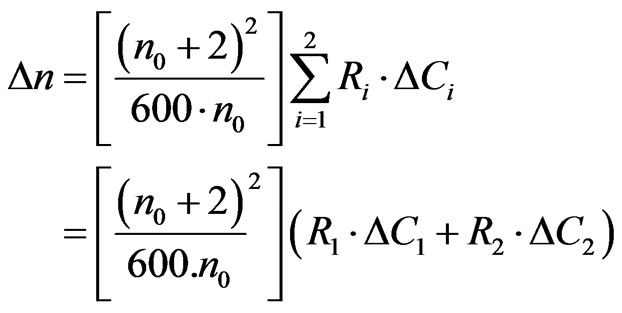 (5)
(5)
where  is the mean refractive index of the medium,
is the mean refractive index of the medium,  and
and  are molar refractive coefficients,
are molar refractive coefficients,  and
and  are the molar extinct coefficient and
are the molar extinct coefficient and  is the deviation from the average concentration.
is the deviation from the average concentration.
To investigate the possible use of DPMG, the volume grating in optical interconnect is replaced by Dynamic Phase Modulated Grating. To analyze the variation of polarization dependence loss with recording angle, Equations (3) and (4) are modified in accordance with Equation (5).
Polarization dependence loss for such DPMG for P and S polarization can be found as
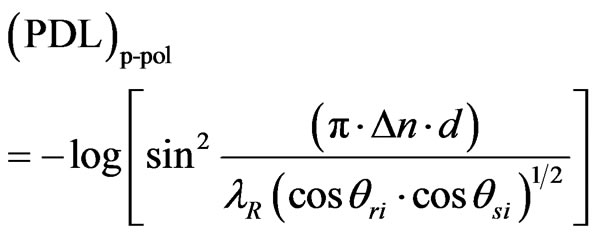 (6)
(6)
and
 (7)
(7)
3. Result and Discussion
We use Equations (6) and (7) to simulate the variation of polarization dependent loss with recording angle. This simulation results show that the polarization dependence loss is zero for P-polarization in the range 1.350 to 1.420, 1.780 to 1.840 and 4.500 to 4.620 angles of recordings.
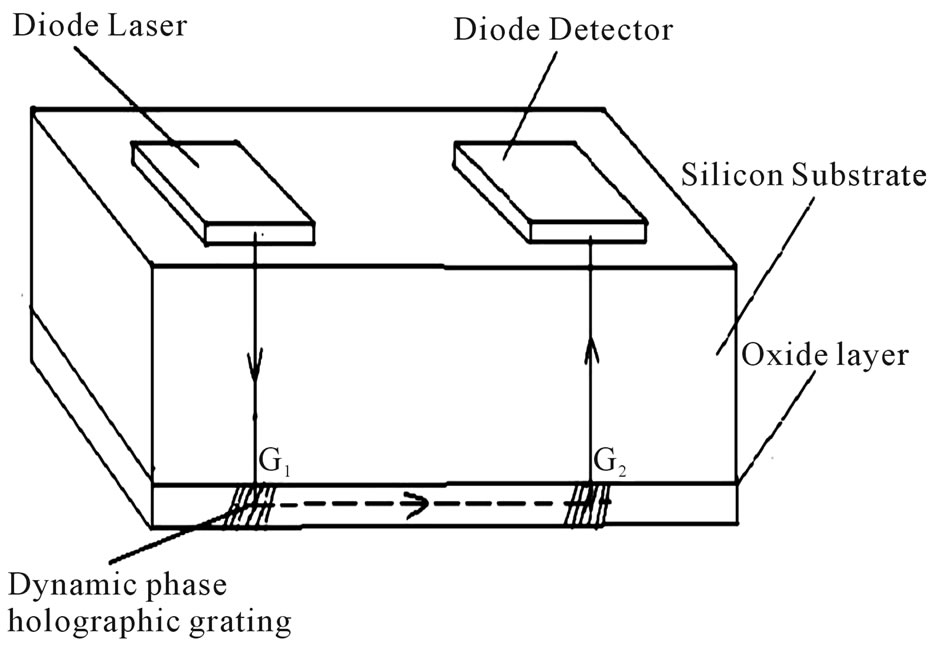
Figure 1. Schematic diagram of vertical interconnection.
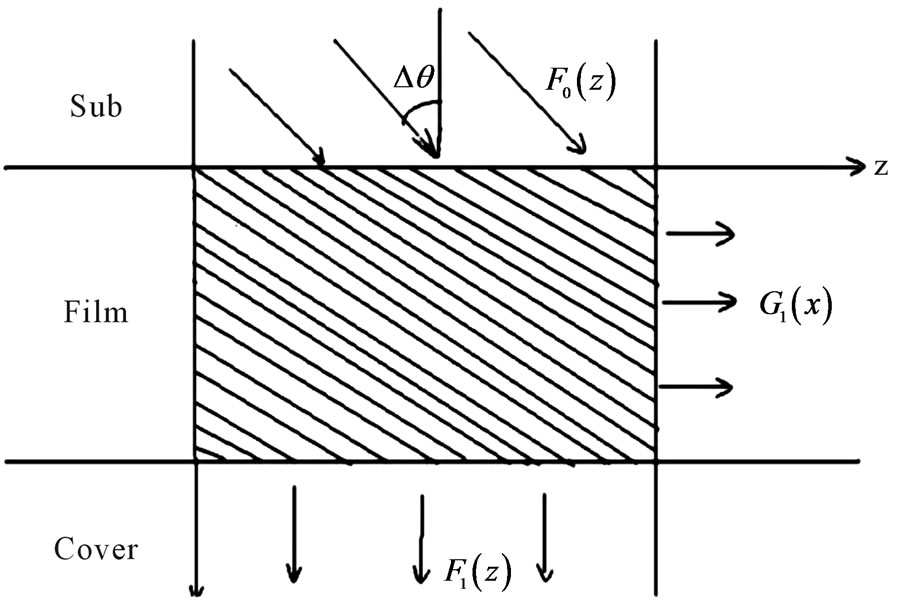
Figure 2. Schematic diagram of dynamic phase modulated grating.
However as the beam is incident normally to grating structure as in Figure 1, only “S” polarization will emerge out of the grating. Thus one has to optimize polarization dependence loss for S-polarization but not Ppolarization. It is found that the polarization dependence loss is minimum for “S” polarization when the recording angles are in the range 1.290 to 1.350, 1.650 to 1.740 and 4.320 to 4.380.
Thickness of grating structure is an important parameter using which, the diffraction efficiency can be optimized. Polarization dependence loss (PDL) thus is expected to depend on thickness of the grating structure; PDL should be different for “P” and “S” polarization. We have simulated the variation of PDL with thickness of grating as shown in Figure 4. It is found from the figure that like Figure 3, this loss is less for “P” polarization compared to “S” polarization. But what is interesting here is that there is a wide range of thickness, where PDL is almost zero For example for thickness in the range 1.2 × 10−3 met to 1.6 × 10−3 met, 4 × 10−3 met to 4.36 × 10−3 met and 6.72 × 10−3 met to 7 × 10−3 met and the polarization dependence loss is almost zero. This suggests that at this range of thickness, diffraction efficiency is maximum. Further it is observed that in the range of thickness 2.56 × 10−3 met to 2.80 × 10−3 met and 5.3 × 10−3 met to 5.6 × 10−3 met, “S” and “P” polarization, PDL difference becomes minimum. But for grating larger thickness range 5.3 × 10−3 met to 5.6 × 10−3 met this difference becomes almost zero. This analysis leads to the following conclusion:
Thickness of the grating structure plays an important role in optimizing the PDL. For certain range of the thickness, PDL becomes almost zero, for “P” polarization and very small for “S” polarization. This difference decreases with the increase of thickness up to a certain range there after again increases. This trend is repeated as the thickness of the grating is increased.
Finally in the Figure 5 variation of polarization de-

Figure 3. Variation of polarization loss with recording angle.

Figure 4. Variation of polarization dependence loss with thickness.
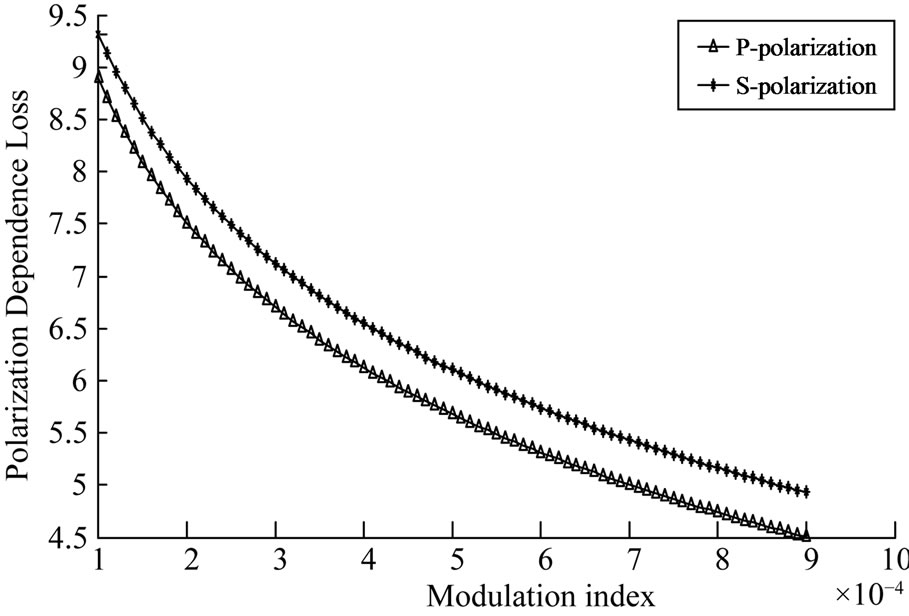
Figure 5. Variation of polarization dependence loss modulation index.
pendence loss with modulation index is shown for both “S” and “P”-polarization. The polarization dependence loss in case of P-polarization is maximum than S-polarization. However in both the cases with the increase of modulation index polarization dependence loss decreases exponentially. To increase the diffraction efficiency, polarization dependence should be minimum and hence the modulation index should be low.
For example for modulation index 1 × 10−4 the polarization dependence loss for “P”-polarization dependence loss is nearly 90%, where as for modulation index 9 × 10−4 the polarization dependence loss for “P”-polarization decreases to zero.
To sum, we have optimized a photopolymer grating, with respect to PDL varying recording angle, thickness of grating and modulation index. It is found that there exists a certain range of recording angle, thickness for which PDL becomes minimum, while PDL becomes minimum for a particular value of modulation index.
4. Conclusion
We have proposed a theory to optimize polarization dependence loss for different polarization (S and P) for a Dynamic Phase Modulated Grating for wavelength 1550 nm. From this theory, it is found that polarization dependence loss can be minimized and diffraction efficiency can be maximized if the hologram can be recorded in the range 1.290 to 1.350, 1.650 to 1.740 and 4.320 to 4.380 for S-polarization. Similarly the polarization dependence loss can be minimized and diffraction efficiency can be maximized, if a grating of thickness in the range 1.2 × 10−3 met to 1.6 × 10−3 met, 4 × 10−3 met to 4.36 × 10−3 met and 6.72 × 10−3 met to 7 × 10−3 met is used for a modulation index of 1 × 10−4.
REFERENCES
- A. E. Willner, “Mining the Optical Bandwidth for a Terabit per Second,” IEEE Spectrum, Vol. 4, No. 34, 1997, pp. 32-41. doi:10.1109/6.583444
- M. Saruwatari, “High-Speed Optical Signal Processing for Communication Systems,” IEICE Transactions on Communications, Vol. 5, No. E78-B, 1995, pp. 635-643.
- N. S. Bergano and C. R. Davidson, “Wavelength Division Multiplexing in Long-Haul Transmission Systems,” Journal of Light-Wave Technology, Vol. 6, No. 14, 1996, pp. 1299-1308. doi:10.1109/50.511662
- B. Nyman, M. Farries and C. Si, “Technology Trends in Dense WDM Demultiplexer,” Optical Fiber Technology, Vol. 7, No. 4, 2001, pp. 255-274. doi:10.1006/ofte.2001.0346
- J. W. An, D. D. Do, N. Kim and K. Y. Lee, “Expansion of Channel Number in Optical Demultiplexer Using Cascaded Photo Polymer Volume Gratings,” IEEE Photonics Technology Letters, Vol. 18, No. 6, 2006, pp. 788-790. doi:10.1109/LPT.2006.871698
- S. Chung, S. Han, T. Kim and B. Lee, “Photopolymer Holographic Grating for a High-Resolution Tunable DeMultiplexer,” IEEE Photonics Technology Letters, Vol. 1, No. 3, 2005, pp. 597-599. doi:10.1109/LPT.2004.842387
- T. Kim, S. Chung, S. Han and B. Lee, “Photopolymer Based Demultiplexer with Superposed Holographic Gratings,” IEEE Photonics Technology Letters, Vol. 17, No. 3, 2005, pp. 618-620. doi:10.1109/LPT.2004.842355
- D. D. Do, N. Kim, J. W. An and K. Y. Lee, “Effects on a Apodization on a Holographic Demultiplexer Based on a Photopolymer Grating,” Applied Optics, Vol. 43, No. 23, 2004, pp. 4520-4526. doi:10.1364/AO.43.004520
- H. Kogelnik, “Coupled Wave Theory for Thick Hologram Grating,” Bell System Technology Journal, Vol. 48, No. 9, 1969, pp. 2909-2947.
- R. K. Kostuk, T. J. Kim, G. Campbell and C. W. Han, “Diffractive-Optic Polarization Sensing Element for Magneto-Optic Storage Head,” Optics Letters, Vol. 19, No. 16, 1994, pp. 1257-1259. doi:10.1364/OL.19.001257
- K.-Y. Lee, S.-H. Jeung, D. D. Do, N. Kim and J.-W. An, “Holographic Demultiplexer with Low Polarization Dependence Loss Using Photopolymer Diffraction Gratings,” Journal of the Optical Society of Korea, Vol. 2, No. 2, 2007, pp. 51-54. doi:10.3807/JOSK.2007.11.2.051
- G. C. Bjorkiund, et al., “A Holographic Technique for Investigating Photochemical Reactions,” Journal of Chemical Physics, Vol. 73, 1980, p. 4321. doi:10.3807/JOSK.2007.11.2.051

